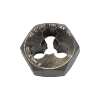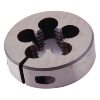In a rather long thread regarding a Queen Anne turn off pistol I am trying to restore the top jaw screw that is stripped. I now have an impression of a functional screw that I may be able to measure a casting from. But the screw the impression was cast from aside from being very small is also over 200 years old and may not provide enough information to absolutely determine the thread diameters and shape. The latest the screw could have been made is 1815. Earlier the Whitworth standards. This screw would have been made to the gunsmith's standard. Whatever that was.
I am certain the major diameter is very close to 13/64" as a #10 screw is too small and a #12 screw is too big. Using wood dowel in the bottom of the jaw I am certain it is 24 TPI. If it's different it isnt measurable. But the wood is too soft to rely on the impression to confirm the depth oh the minor dimension or angle or shape of the thread. Every attempt to get an impression from the bottom jaw with a stiffer material has failed.
I suspect that once done with casting from the impression have now I will still not know for sure the actual diameters or thread angle or shape. I may very well be left with rethreading to a modern thread. 13/64-24 certainly isn't modern and likely obsolete, but it is going to be the closest to what is actually in the screw now. 13/64-24 isn't available on the internet but maybe someone here has a source of obsolete tap and dies.
I could rethread to a modern 12-24 but would prefer to remain as close to the original as possible. Although I haven't figured out how, I'd love to be able to build up the original screw to fit the thread instead of making/using a modern top jaw screw. Welding material onto a 200 year old screw is hit or miss according to my local gunsmith.
Here is a link to the original thread. It is long and address' many topics. It's a fun read if you have a lot of time.
https://www.thehighroad.org/index.p...-own-queen-anne-turn-off-pistol.889724/page-4
And at least @Big Bore 44 has seen it in an old manual.
I am certain the major diameter is very close to 13/64" as a #10 screw is too small and a #12 screw is too big. Using wood dowel in the bottom of the jaw I am certain it is 24 TPI. If it's different it isnt measurable. But the wood is too soft to rely on the impression to confirm the depth oh the minor dimension or angle or shape of the thread. Every attempt to get an impression from the bottom jaw with a stiffer material has failed.
I suspect that once done with casting from the impression have now I will still not know for sure the actual diameters or thread angle or shape. I may very well be left with rethreading to a modern thread. 13/64-24 certainly isn't modern and likely obsolete, but it is going to be the closest to what is actually in the screw now. 13/64-24 isn't available on the internet but maybe someone here has a source of obsolete tap and dies.
I could rethread to a modern 12-24 but would prefer to remain as close to the original as possible. Although I haven't figured out how, I'd love to be able to build up the original screw to fit the thread instead of making/using a modern top jaw screw. Welding material onto a 200 year old screw is hit or miss according to my local gunsmith.
Here is a link to the original thread. It is long and address' many topics. It's a fun read if you have a lot of time.
https://www.thehighroad.org/index.p...-own-queen-anne-turn-off-pistol.889724/page-4
And at least @Big Bore 44 has seen it in an old manual.
Just looking in my old lathe manual, there is a 13/64 X 24tpi listed. Major dia.(o.d.) is listed as .2031" Minor dia (inside of cock) should be around .1490" (wear may cause slightly bigger measurement.)







